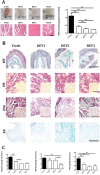Long-term cryopreservation of decellularised oesophagi for tissue engineering clinical application
- PMID: 28599006
- PMCID: PMC5466304
- DOI: 10.1371/journal.pone.0179341
Long-term cryopreservation of decellularised oesophagi for tissue engineering clinical application
Abstract
Oesophageal tissue engineering is a therapeutic alternative when oesophageal replacement is required. Decellularised scaffolds are ideal as they are derived from tissue-specific extracellular matrix and are non-immunogenic. However, appropriate preservation may significantly affect scaffold behaviour. Here we aim to prove that an effective method for short- and long-term preservation can be applied to tissue engineered products allowing their translation to clinical application. Rabbit oesophagi were decellularised using the detergent-enzymatic treatment (DET), a combination of deionised water, sodium deoxycholate and DNase-I. Samples were stored in phosphate-buffered saline solution at 4°C (4°C) or slow cooled in medium with 10% Me2SO at -1°C/min followed by storage in liquid nitrogen (SCM). Structural and functional analyses were performed prior to and after 2 and 4 weeks and 3 and 6 months of storage under each condition. Efficient decellularisation was achieved after 2 cycles of DET as determined with histology and DNA quantification, with preservation of the ECM. Only the SCM method, commonly used for cell storage, maintained the architecture and biomechanical properties of the scaffold up to 6 months. On the contrary, 4°C method was effective for short-term storage but led to a progressive distortion and degradation of the tissue architecture at the following time points. Efficient storage allows a timely use of decellularised oesophagi, essential for clinical translation. Here we describe that slow cooling with cryoprotectant solution in liquid nitrogen vapour leads to reliable long-term storage of decellularised oesophageal scaffolds for tissue engineering purposes.
Conflict of interest statement
Figures




Similar articles
-
Decellularised whole ovine testis as a potential bio-scaffold for tissue engineering.Reprod Fertil Dev. 2019 Oct;31(11):1665-1673. doi: 10.1071/RD19070. Reprod Fertil Dev. 2019. PMID: 31217071
-
Whole rat stomach decellularisation using a detergent-enzymatic protocol.Pediatr Surg Int. 2019 Jan;35(1):21-27. doi: 10.1007/s00383-018-4372-8. Epub 2018 Nov 16. Pediatr Surg Int. 2019. PMID: 30443739 Free PMC article.
-
Investigation of a small-diameter decellularised artery as a potential scaffold for vascular tissue engineering; biomechanical evaluation and preliminary cell seeding.J Mech Behav Biomed Mater. 2012 Oct;14:130-42. doi: 10.1016/j.jmbbm.2012.06.001. Epub 2012 Jun 15. J Mech Behav Biomed Mater. 2012. PMID: 23026691
-
An overview of decellularisation techniques of native tissues and tissue engineered products for bone, ligament and tendon regeneration.Methods. 2020 Jan 15;171:28-40. doi: 10.1016/j.ymeth.2019.08.002. Epub 2019 Aug 5. Methods. 2020. PMID: 31394166 Review.
-
Nanotechnology-based Cryopreservation of Cell-Scaffold Constructs: A New Breakthrough to Clinical Application.Cryo Letters. 2016 Nov/Dec;37(6):381-387. Cryo Letters. 2016. PMID: 28072423 Review.
Cited by
-
The cell-assembled extracellular matrix: A focus on the storage stability and terminal sterilization of this human "bio" material.Acta Biomater. 2023 Aug;166:133-146. doi: 10.1016/j.actbio.2023.05.002. Epub 2023 May 5. Acta Biomater. 2023. PMID: 37149079 Free PMC article.
-
Tissue Engineering for Gastrointestinal and Genitourinary Tracts.Int J Mol Sci. 2022 Dec 20;24(1):9. doi: 10.3390/ijms24010009. Int J Mol Sci. 2022. PMID: 36613452 Free PMC article. Review.
-
Decellularized Colorectal Cancer Matrices as Bioactive Scaffolds for Studying Tumor-Stroma Interactions.Cancers (Basel). 2022 Jan 12;14(2):359. doi: 10.3390/cancers14020359. Cancers (Basel). 2022. PMID: 35053521 Free PMC article. Review.
-
Perfusion decellularization of a human limb: A novel platform for composite tissue engineering and reconstructive surgery.PLoS One. 2018 Jan 19;13(1):e0191497. doi: 10.1371/journal.pone.0191497. eCollection 2018. PLoS One. 2018. PMID: 29352303 Free PMC article.
-
Regenerative medicine: current research and perspective in pediatric surgery.Pediatr Surg Int. 2023 Apr 4;39(1):167. doi: 10.1007/s00383-023-05438-6. Pediatr Surg Int. 2023. PMID: 37014468 Free PMC article. Review.
References
-
- Mansbridge J. Commercial considerations in tissue engineering. J. Anat. 2006; 209: 527–532. doi: 10.1111/j.1469-7580.2006.00631.x - DOI - PMC - PubMed
-
- Ferlay J, Shin HR, Bray F, Forman D, Mathers C, Parkin DM. Estimates of worldwide burden of cancer in 2008: GLOBOCAN 2008. Int. J. Cancer. 2010; 127: 2893–2917. doi: 10.1002/ijc.25516 - DOI - PubMed
-
- Spitz L. Oesophageal atresia. Orphanet J. Rare Dis. 2007; 2: 24 doi: 10.1186/1750-1172-2-24 - DOI - PMC - PubMed
-
- Zani A, Pierro A, Elvassore N, De Coppi P. Tissue engineering: an option for esophageal replacement? Semin. Pediatr. Surg. 2009; 18: 57–62. doi: 10.1053/j.sempedsurg.2008.10.011 - DOI - PubMed
-
- Totonelli G, Maghsoudlou P, Garriboli M, Riegler J, Orlando G, Burns AJ, et al. A rat decellularized small bowel scaffold that preserves villus-crypt architecture for intestinal regeneration. Biomaterials. 2012; 33: 3401–3410. doi: 10.1016/j.biomaterials.2012.01.012 - DOI - PMC - PubMed
MeSH terms
Substances
Grants and funding
LinkOut - more resources
Full Text Sources
Other Literature Sources

